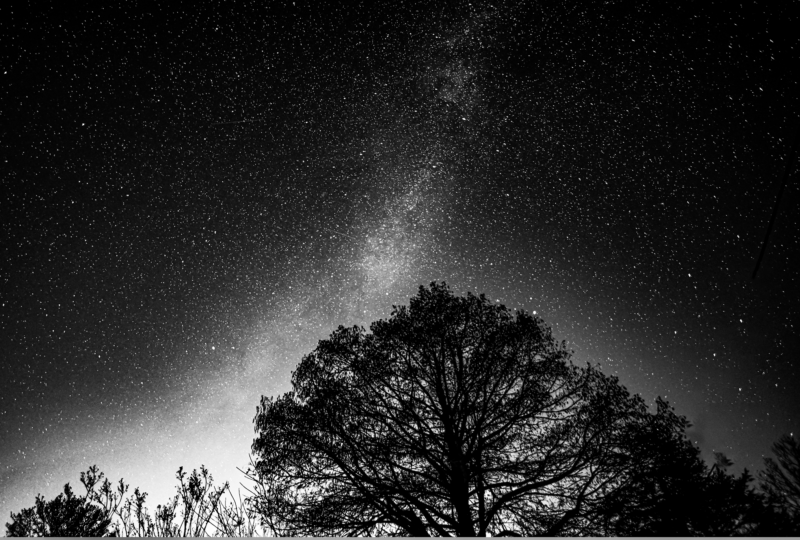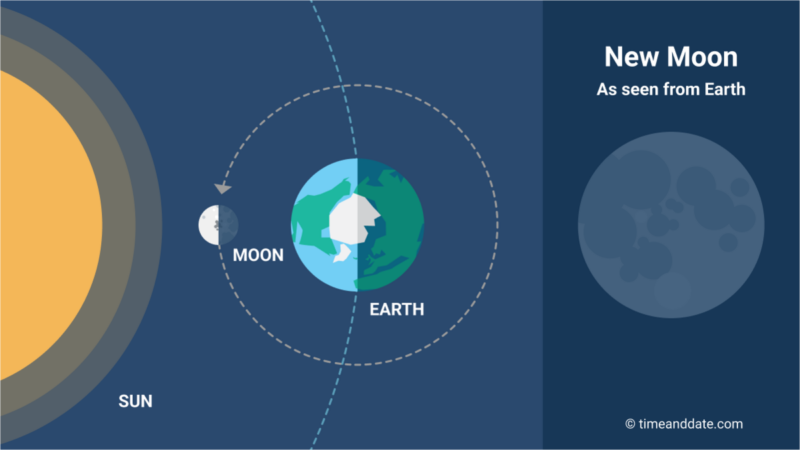The moment of new moon will fall at 6:06 UTC on August 23, 2025. That’s 1:06 a.m. CDT. Many will call this moon a Black Moon. Join EarthSky’s Deborah Byrd at 12:15 p.m. CDT (17:15 UTC) on Tuesday, August 19, as she talks about the role of Black Moons in astronomy! Watch in the player above, or on YouTube.
Black Moon coming on August 22-23
When we have two full moons in a single month, we in astronomy call the 2nd one a Blue Moon. That’s a relatively recent name and definition. The folklorist Philip Hiscock traced the modern usage of the term Blue Moon back into the 20th century in a 1999 article. Now, it seems, journalists and astronomy buffs have begun using the name Black Moon for the 2nd new moon in a single month. We have a Black Moon coming up on August 22-23, 2025 … but its definition, though still following the rules for Blue Moons, is slightly different.
That is, a Blue Moon can also be the 3rd of four full moons in a season. And so, apparently, can Black Moons. Who decides these things? We do! It’s folklore, not official astronomy. And that means we, the folk, decide.
So the next Black Moon is August 22-23. Blue Moons and Black Moons follow the same rules. And the modern definition for Blue Moons has been studied by professional folklorists.
But where did the term Black Moon come from?
What is it?
Blue Moons and Black Moons have entirely different histories. Blue Moons stemmed from a mistake in a 1946 article in Sky & Telescope magazine. A writer mistakenly quoted the Old Farmer’s Almanac, calling the 2nd of two full moons in a month a Blue Moon. And, in the 1970s and ’80s, other astronomy writers picked up this 2nd-full-moon-in-a-month definition and popularized it (read about the popularization of Blue Moons in the Hiscock article).
But Black Moons didn’t really make an appearance on the astronomy scene until … well, I’m not sure when … but more recently than Blue Moons.
Still, I can recall reading about Black Moons in Sten Odenwald’s great blog The Astronomy Cafe some decades ago. How many decades? That I couldn’t tell you. I tried to find Sten to ask him, but couldn’t track him down. My recollection is that he said the term Black Moon came from Wiccan culture. And ChatGPT mentioned that connection, too, when I asked it this weekend.
I’m also reading this year – at the StarWalk website – that the expression Black Moon is used when there’s no new moon in a month. We typically do have a full moon and a new moon each month. I had not heard that definition of Black Moon, in all my 50 years of writing about the night sky. But there you go. The folk will have it!
 View at EarthSky Community Photos. | Chuck Reinhart captured this starry scene from Vincennes, Indiana, in November 2024. Thank you, Chuck! This dark starry sky is like what you’ll see around a new moon. The 3rd new moon this astronomical season (June solstice to September equinox) – called a Black Moon – will fall on August 22-23, 2025. New moons rise and set with the sun. So nights around the new moon are dark and perfect for stargazing.
View at EarthSky Community Photos. | Chuck Reinhart captured this starry scene from Vincennes, Indiana, in November 2024. Thank you, Chuck! This dark starry sky is like what you’ll see around a new moon. The 3rd new moon this astronomical season (June solstice to September equinox) – called a Black Moon – will fall on August 22-23, 2025. New moons rise and set with the sun. So nights around the new moon are dark and perfect for stargazing.
When is it?
This 2025 seasonal Black Moon – otherwise known as this month’s new moon – will fall at 6:06 UTC (1:06 a.m. CDT) on August 23. So it might fall on August 22 for you, depending on your time zone. A Black Moon – like any new moon – isn’t visible in Earth’s sky. The moon is new when it’s more or less between the Earth and sun for that monthly orbit. So, at every new moon, the moon travels close in our sky to the sun. For all of Earth, it’s up in daylight and can’t be seen.
But new-moon-time is a great time to stargaze, because without the moon in the sky, the night is darker, and you can see more stars. This is especially true if you venture out to a dark-sky site.
Black Moon fun facts
Monthly Black Moons happen about once every 29 months. That’s the definition of a Black Moon as the 2nd of two new moons in a calendar month.
Seasonal Black Moons happen about once every 33 months. That’s the definition of a Black Moon as the 3rd of four new moons in a season.
The last seasonal Black Moon, prior to this August 2025 Black Moon, was May 19, 2023. And the next one will be August 20, 2028.
The last monthly Black Moon was December 30-31, 2024. And the next monthly Black Moon will be on August 31, 2027.
The name Blue Moon can be misleading. The moon doesn’t appear blue in color during these full moons. But the name Black Moon is slightly more accurate, because you can’t see the moon in the night sky (because it’s up in the daytime!). Also, if you think about the body of the moon itself … its darkened half is facing Earth at the time of new moon.
More cool Black Moon events
We’ll have a super Black Moon on August 20, 2028. It’ll be a new moon nearly coinciding with perigee, the moon’s closest point to Earth for that month. Read about supermoons here.
We’ll have three Black Moons in a row in 2033 if you are okay with the definition that no new moon means a Black Moon. In other words, in 2033, the new moon of January 30 and March 30 will be the second in a month. And there will be no new moon in February. That’s a black Moon triple whammy!
 A Black Moon really does appear dark from Earth. Its darkened half is facing Earth at that time. But you can’t see a Black Moon. Like any new moon, it travels across the sky with the sun during the day, hidden in the sun’s glare. Image via TimeandDate.com. Used with permission.
A Black Moon really does appear dark from Earth. Its darkened half is facing Earth at that time. But you can’t see a Black Moon. Like any new moon, it travels across the sky with the sun during the day, hidden in the sun’s glare. Image via TimeandDate.com. Used with permission.
Bottom line: We’ll have a Black Moon on August 22-23, 2025. A Black Moon is a special kind of new moon. Learn more about Black Moons here.
Source 1999: Folklore of the Blue Moon by Philip Hiscock
Source 2012: Where does the phrase ‘once in a Blue Moon’ come from? Sky and Telescope
Deborah Byrd
View Articles
About the Author:
Our Editor-in-Chief Deborah Byrd works to keep all the astronomy balls in the air between EarthSky’s website, YouTube page and social media platforms. She’s the primary editor of our popular daily newsletter and a frequent host of EarthSky livestreams. Deborah created the EarthSky radio series in 1991 and founded EarthSky.org in 1994. Prior to that, she had worked for the University of Texas McDonald Observatory since 1976, and created and produced their Star Date radio series. She has won a galaxy of awards from the broadcasting and science communities, including having an asteroid named 3505 Byrd in her honor. In 2020, she won the Education Prize from the American Astronomical Society, the largest organization of professional astronomers in North America. A science communicator and educator since 1976, Byrd believes in science as a force for good in the world and a vital tool for the 21st century. “Being an EarthSky editor is like hosting a big global party for cool nature-lovers,” she says.